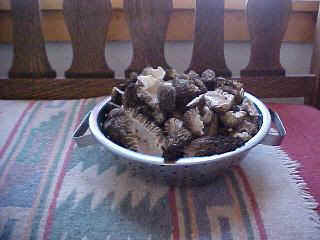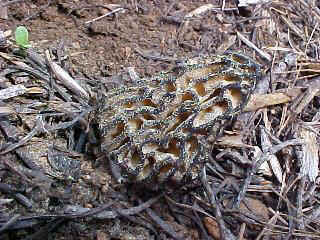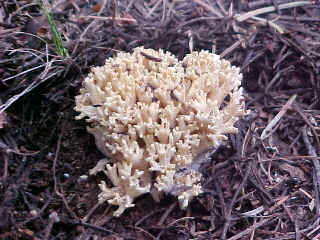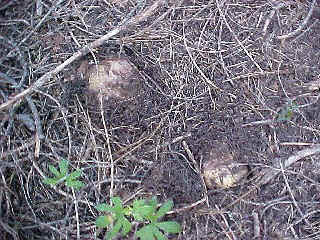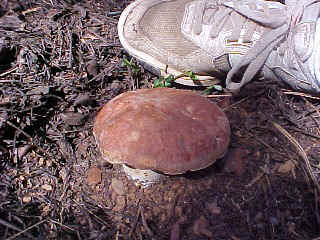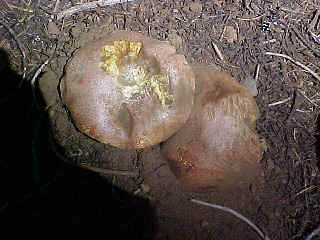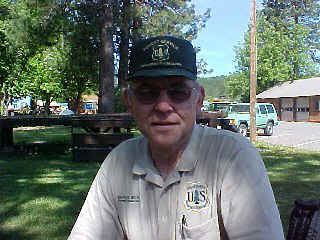|
Like the previous dry year, this year was no exception. However, we did find enough morels to last us awhile, along with a good supply of the Spring King Boletes (Boletus pinophilus). Towards the summer we started finding some Boletus abieticola, the Butter Bolete, and later, the B. regius, the Red-capped Butter Bolete. I finally found my first Agaricus augustus, the Prince, in my daughter’s front yard, and I think it is now my favorite mushroom to eat. I also found two new species for me, the Gautieria monticola and the Gyromitra californica. The Gautieria monticola is a so-called edible tuber. The Gyromitra californica looks like a rather large, tan Helvella. This year I was able to help identify a few odd-looking mushrooms, all via email. It made me feel kind of useful for a change. Findings, April, 2001 to July, 2001 (top) Sunday, April 29: Today I went down to Caribou Road (south of Greenville) to see how the MSSF foray group was doing and to visit a bit, but everyone was already gone by the time I got there. I went about 5 miles up the access road to see if anyone was up that way, but saw nobody and found only dust. Somewhat encouraged by another member’s report, Monday I went the back way to the Storrie fire via Humboldt Road. I got right into the middle of the burn area, but everywhere there was more dust as most of the all the duff was burned away. I found a few moist areas with some duff covering it at the edge of the fire, but no morels, YET. Then I went closer to Lake Almanor and found a bit of moister ground along with 3 Gyromitra gigas/montana (Snow Mushrooms), several pink-like but large Sarcosphaera crassa, a few pink-tinged probably Hygrophorus purpurascens, a few white Tricholomas, a solitary probably Discina perlata, some probably Sarcoscypha coccinea red cup fungus, a group of tan cup fungus, some pretty dry Ganoderma applanatum, and a few small as yet unidentified tan mushrooms. Up this way, the S. crassa usually appears just before the morels do! Maybe this is a good sign. Maybe after a few weeks and a few inches of rain, things will get better up here in the Sierras. We still are at less than 50% of our normal rainfall. Saturday, May 5: With all the recent warm weather, I figured it was a good idea to go back to some of our "favorite spots", and see what came up since our last hunt. We took a long walk near a local lake above town and eventually got into some old logging sites. There, we found some unidentified tan Tricholoma, some Sarcosphaera crassa, a few Scarlet Cup Fungi, and one morel. We then started looking a bit more diligently and found small pockets of moisture and more morels. We almost filled a small bag I was carrying. We left for lunch, and on the way back towards home we stopped at a few other "favorite spots" and found a few more morels, plus a couple of aging Agaricus silvicola, a young, yellow-tipped Ramaria, more of the same mushrooms like the last spot, a Cortinarius or two, and a fairly robust Entoloma. Some of the morels were actually old and dry, but most were fresh and bug-free. They were few and far between, but after 4 hours, we accumulated over 2 lbs. Monday, May 7: I went back to the same spots we went to on Saturday, and in 2½ hours, I picked another 2 lbs. of morels, BY MYSELF! (Cecelia found most of the last bunch).
I found small groups right where I had picked some two days ago. I will probably go back to this same spot in a few days. Saturday, May 12: For the past few days, about every other day I have been going back to my favorite morel spot above town. Each time I went, I would find at least 1 lb. of morels before I got tired of walking. Today was no exception. Some were pretty dried up, but must were moderately sized and fresh. As always, Sarcosphaera crassa were always present too. I think many of the morels are those that I missed before my eyes got more calibrated for the elusive suckers, those masters of disguise. If I hadn't read in Arora's new book about the possible high concentration of Arsenic in them, I would collect the S. crassa for the table. Like I said before in another newsletter, they kind of tasted to me like sweet onions when sliced in thin strips and cooked in butter.
Monday, May 14: Later today, we went back to one of the spots we had been collecting a few morels. We only found 11 but did find two 2½"-diameter Fuzzy Truffles, or Geopora cooperi. I saw the small mounds and at first thought they were more of the Sarcosphaera crassa, which were very abundant everywhere. Instead of the typical hollow sound when I thumped them, they appeared solid. I dug them up, recognized them as the Geopora, and took them home. When I got there, I cleaned them, sliced them into ¼" thick pieces, and finally cooked then in butter and olive oil along with one of the morels. I thought the flavor of the Geopora was better than the morels! Next time I will check ALL the mounds. We also found a fresh Ramaria rasilispora, which I photographed but left behind. It too is pretty abundant, so I might give it a try again.
Monday, May 21: Today, inspired by a report of finding the Spring King Bolete, the Boletus pinophilus, at 5000 ft. in spite of the dry conditions, I went to a spot near town, at about 4400 ft. and found a few myself. One was large, and the rest were medium-sized, but all but one small one was worm-free. All had the reddish-brown cap. I am cooking them as I type, in olive oil and butter, as per one of Mycochef Patrick Hamilton’s suggestions. Wednesday, May 23: Went back to the same places two days after the last find, and found more Boletus pinophilus. I rechecked my 6 boletus spots, and where only 3 spots were productive the last time, this time only the other 3 produced results. I found no morels at the area but did find a few of the Ramaria rasilispora, from which I well cooked the tops and added them to a salad. A nice addition. Thursday, May 24: I decided to try my luck by going north of Chester, on Highway 36.. I stopped at a campground where I usually find SOMETHING, but found only a few B. pinophilus and nothing else. It looked much too dry everywhere. But like Larry Stickney once said, "there are always mushrooms somewhere." Monday, May 28: We went back to a few of our "spots" around 4400 ft. to see if the Boletus pinophilus were still popping up. We found about 6 or 7, but when we brought them home, they looked too bug-infested to want to go back for more, even the smallest ones. I think this announces the end of the Spring King Bolete season at 4400 ft around here. I must check those higher elevations! Later that day we tried a few other "spots" at around the same elevation and found a nice variety of mushrooms: a hardball-sized puffball (probably a Calvatia sculpta or Calbovista subsculpta), a few yellow amanita, various cortinarius including a C. magnivelatus with its persistent veil, a small patch of the Agaricus silvicola, some rather large yellow fleshed boletus that stained blue with pores that were turning reddish, and several of the yellow coral mushrooms, the Ramaria rasilispora. The agaricus, bolete, and the Ramaria were too old or dry to be worth taking home. So I only took the puffball. Tuesday, May 29: Encouraged by a report that there were boletes and morels to be found at an elevation a bit higher than Lake Almanor, I went to check out a campground above Chester, mainly to check for Boletus pinophilus. Near the side of the road that goes through the campground, I found a spot with many tiny boletus buttons in clumps about 6-8 inches across, and made a mental note to return in a week or two to see how big they had become. Near the same area I found a few larger buttons, some big enough to pick. I also saw many fresh yellow coral mushrooms, and as I was ready to leave, I found one fresh morel, about 3" tall. Not too bad for the day after the Memorial Day weekend. I then went to an area west of the campground to check out a year-old logging operation where I had found a few morels recently, to see if I could find more. I didn't see any morels, but I did find two large B. pinophilus that looked bug-free and were very firm. On the way home, I went to another campground in the area and drove slowly through, looking for mushbumps. I found another, medium-sized bolete, although half had been chewed off, probably by a deer. When I cleaned the boletes at home, most except the smaller buttons had only a few bugs, and I was left, finally, with a good amount of cooked boletes. So I will return! Friday, June 1: Today we decided to check out the Yuba Pass area. It was very dry (again!) all around there too. We searched from the Bassets Store to the top of the pass, and found very little except fresh or old, yellow and brown Ramaria. At Chapman Campground we found one old Agaricus, probably an A. silvicola, and a wormy, yellow-fleshed, bluing red-topped boletus, probably a B. regius. On the top of the pass Cecelia found one third of a Boletus pinophilus. We took it with us. On the way home, at Gold Lake, we found a few small puffballs. Saturday, June 16: While showing some friends a campground above Chester, at around 4800 ft, we found several mushroom mounds, each yielding a somewhat young and firm boletus. There were some tan-capped, white-fleshed B. pinophilus (Spring King Bolete), some tan-capped, yellow-fleshed boletes, the B. abieticola (Butter Bolete) and red-capped B. regius (Red-capped Butter Bolete). Only a few parts of some showed signs of bug activity. I am figuring the recently cooler weather may have kept the ground moist enough for this fruiting. The sizes varied from 3" to 4" in diameter. Tuesday, June 19: I went back to the same campground above Chester where I found all the boletes Saturday, and found much more this time. All were bigger, but there were more bugs too. I found a few B. pinophilus and the rest were mainly B. regius. A few looked like B. abieticola. Many showed the sign of deer tastings. I filled a large frying pan with the cleaned find. We plan to make our favorite, mushroom strudel, using them all mixed together. Friday, June 22: Yes, the season continues. This morning I went back to my boletus spot north of Chester, and found 5 good-sized Boletus abieticola. All were firm, and all but 1½ were bug free. I also found close to a stream bed, what looked like a large, brown, Helvella-like mushroom, the keyed out to be a Gyromitra californica, also known as a Helvella californica. A nice looking specimen with its broad cap and white underside with reddish tones towards the bottom of the fluted stem. Under a small mound I found a 2" diameter tuber which, with the help of my trusty microscope, keyed out to be a Gautieria monticola. Arora says it is edible but rubbery, so I tried a sample. Not worth sampling again.
Wednesday, July 11: Encouraged by a small amount of rain that had been falling in this area, I went back up to my favorite campground above Chester, and found 3 Red Capped Butter Boletes (B. regius), all within a few feet of each other. Two were mostly consumed by something, probably a deer, but the one that was still below the surface was whole and relatively bug-free. When picked young, the taste and texture of the cooked regius is pretty good! These remained yellow even after cooking. Saturday, July 28: Went to a lake above town and found a small grouping of Lentinus ponderosus next to a stump. I cooked them later and added them to a stir-fry. Not bad. Mushroom-Picking Permits for Plumas and Lassen National Forests (top) It finally happened. Both the Plumas and Lassen National Forests are now requiring permits to collect mushrooms both for personal use and for commercial use. It started last year but I did not find out about until this year. Tuesday, April 24: I went to the Plumas NF and Lassen NF Ranger stations to get my "for personal use" mushroom-picking permits. I seemed to have been one of the first persons to ask for a permit at both stations. The permits for both the Lassen NF are good for all Ranger Districts in that forest, according to Carrie at the Plumas Mt. Hough Ranger District office. That's a relief. However, the permit for Lassen is for 10 lbs. total, for 3 non-consecutive days ONLY, and expires on July 31, 2001. After that, any mushroom picking would be illegal, according to the woman I talked to. She really didn't know whether or not a different permit would be offered to cover the rest of the year, so she gave me a number to call at the Supervisor's office. He was out today. Another person who came in applying for a free personal and a commercial permit, had just been cited by a USFS Ranger for having some mushrooms on his possession without a valid personal mushroom-picking permit. He was told that he could get a fine, but just got a warning citation, THIS TIME. He had been picking close to Payne's Creek (close to Redbluff) and was told he had to go the all the way up to the Lake Almanor Ranger District Office to obtain a permit. The Lassen permit says it has a $10 value (for free) for 10 lbs,. of mushrooms at $1 a lb. It seemed to take about an hour for him to get his permits. Mine went faster. I raised a lot of questions and issues, but got little satisfaction from the replies. The Ranger at Plumas just took my $10 and gave me a permit for $10 lbs. of mushrooms, with the permit expiring on 7/15/01. He said "Don't worry about it", when I expressed my concern about knowing where I was when I found a mushroom, and also did not know if there were going to be different permits issued after the 15th of July. He didn't seem to like the permits very much. Both permits were on the same form, but with a few differences. Both required that you fill in how much you find and the day you find it. The Plumas permit said that it had to be worn in view on an outer garment, and didn't say you couldn't sell the mushrooms. The Lassen said that it was not valid on private land, listed the 3 non-consecutive day limit and said you could not sell the mushrooms. I am sure most of you have had similar experiences by now, but this was my first experience with the permits. Monday, May 21:This morning I had a meeting with a representative of the Plumas NF, Charles Brown, regarding their permit requirements for picking mushrooms for personal (and commercial) use in the National Forest, primarily for the Plumas NF.
I felt the meeting went well, and that next year, the permit may be free and unlimited for personal use. Nothing would change this year, but the permit requirement will most likely still be there next year, but with a mail-in form being offered, at least in the Plumas NF. Hopefully, the mail-in form will be available for all the forests requiring permits, and hopefully, all will be free and unlimited for personal use. A call or letter to a particular forest might help in this regard. I left with more of an understanding of what started the permit requirement. It seems that the local offices panicked after meeting with a representative from the Klamath NF. They know now that they may have overreacted. Basically, the permit was issued to help give them an understanding of what the resources were that were being removed, NOT to penalize anyone for not having a permit. He agreed that they were working in a vacuum as far as mycological information was concerned. That is where the members of mushroom interest groups can be a great service, providing this kind of information to them. We both agreed that a handout given out with the permit explaining the purpose of the permit and also explaining a bit about how to pick mushrooms without leaving a mess, would be very helpful. I left him with a copy of Mike Boom's article about picking mushrooms, which he was pleased to accept. Tuesday, May 29: On the way to the Storrie burn site, I was stopped by the USFS Law Enforcement unit and was asked if I had my mushroom picking permit. After saying yes, I talked a while with them about the mistakes with their permits, and they actually sounded interested. I later talked over the phone with Phil Sitze at the Lassen NF Supervisor’s office, concerning the mushroom permits, and he later sent me a message telling me that he was going to discuss the issues I brought up with him with the Forest Supervisor (through the "ecosystem manager"). Below is a response from Phil Sitze. The good news is that both the Lassen and Plumas now have mail-in permits and that they may both be free next year. The 10-lbs. limit I am sure can be changed, if enough people who might be affected by it, sent in complaints. Because I am so close to the forest, 10 lbs. a day is probably enough for me. I am going to push for a limit per species, with no limit for those species not listed on the permit. Maybe they will even eventually come up with a National permit. Philip Sitze/R5/USDAFS To: Herman Brown Sent: Tuesday, May 29, 2001 Subject: Re: Meeting with Lassen NF I talked to Charlie Brown last week after you met with him. I also was able to talk to the Forest Supervisor this morning and fill him in on what has been transpiring. He is very interested in what we have learned this year but is not willing to change anything this year. I have it set up to meet with him this winter and I also indicated to him the importance of the Plumas and the Lassen being consistent. There is a push to tracking forest products even if they are free. We are using a national system now called TIM (Timber Information Management) which is the tool to issue all permits and will eventually create contracts for Timber etc. He will use the information from this year to see in what places we have impacted other areas such as free use. I think where we are headed is to a free permit that will cover from spring through say October 31st each year but will have a limit of 10# per day. This is something new to people but consequences from Law Enforcement is usually to have those people found with no free permit to go and get one and become compliant. We also are willing to mail permits. This has actually affected our front desk some in business. We also will look at our commercial permits and controlling buyers if possible. I appreciate your information. I have developed a folder for which I am collecting information to use as documentation for the Forest Supervisor. We will plan on publicity early next year that will explain things and also give directions on how to pick without impacting future mushroom growth. You were pretty right on with your predictions of mushrooms this year. Talk to you later. - Phil And in August, after a request for information about the rest of the year, again from Phil Sitze:
Good news so far. And finally, on September 4th, I was told by Charles Brown from the Plumas National Forest, that no permits would be required in that forest for the rest of this year. Good news again. A Recipe for Morel-Stuffed Baked Potatoes (top) This recipe was a result of my giving some fresh morels to a friend, Susan French from Santa Ynez, when she was up here visiting her sister in Greenville this spring: Susie's Morel-Stuffed Baked Potatoes
You will also need:
Bake the potatoes until soft. While they are baking, sauté onions, garlic and morels in 1 tbsp. butter and 1-2 tbsp. olive oil until soft, about 10-12 minutes. Add about 5-6 tbsp. sherry after 5 minutes. Remove potatoes from oven and cool until you can handle them. Cut in half and scoop out the potato meat. Mash the potatoes and add 1-2 tbsp. butter, 3-4 tbsp. sour cream. Mix well, adding milk as you need to soften the mixture. Add fresh chopped parsley, about 1-2 tbsp., salt & pepper to taste. Stir in the cheese, usually about ½ cup. Re-stuff the potatoes. Add a small pat of butter on top, lightly cover with foil and bake at 325F for 20-25 min. until cheese has melted and potatoes are hot. Serves 4 And another recipe from a new friend, Paula Reynolds, in New Hampshire A Recipe for Eggplant and Mushroom Lasagna (top) Paula Reynold’s Serves an army. Or 8 normal people (if you know any). Do ahead: sauces, cheese mix, prepare vegetables. Boil noodles (which you can oil and store in a plastic bag until you’re ready.) I do a lot of this work the day before, or, in the case of the red sauce, even further ahead (it’s better after a couple of days anyway.) The cheese mix shouldn’t be done too far ahead, because of the raw eggs in it. Note that amounts of most ingredients are very flexible, to taste. For this reason, this recipe is more of a method than it is a recipe. The only important proportions in this recipe are for the flour/butter/milk in the white sauce. You could also throw the mozzarella and Parmesan into the cheese mix. Do not throw from a grate (hehehehe!) distance, however, as mozzarella sticks to the floor. Sauces :
Melt butter, stir in flour, cook on low heat 2 min. Whisk in the milk (if it’s heated, the sauce makes up much faster.) Cook just until thickened. Stir in seasonings. You’re done. Whew! If you like a lighter lasagna, cut back on the red sauce (or save some for another meal) make 3 cups of white sauce (using 6T. each butter and flour, and 3 c. milk, a little more seasoning)
Featured Mushroom, Laetiporus sulphureus (Sulphur Shelf) (top) This issue’s featured mushroom is the Laetiporus sulphureus, better know in California as the Sulphur Shelf. I have never found it fresh up here in the Sierras, but expect to someday. It usually is found on stumps or growing out of the side of dead or dying trees, and is a spectacular sight when it IS fresh, with its sometimes-bright yellow color. Here is the link to the Laetiporus sulphureus at the Mykoweb website: Laetiporus sulphureus |


